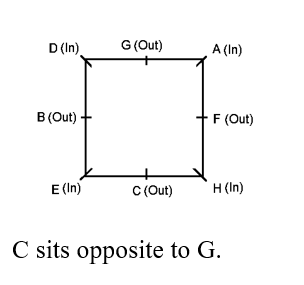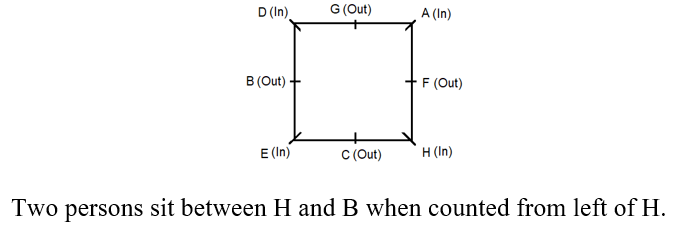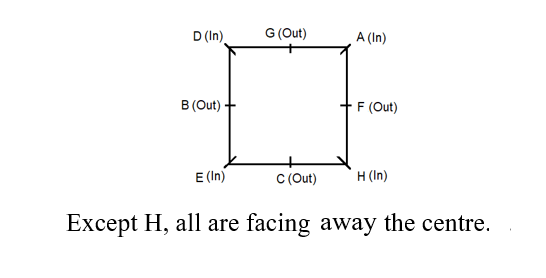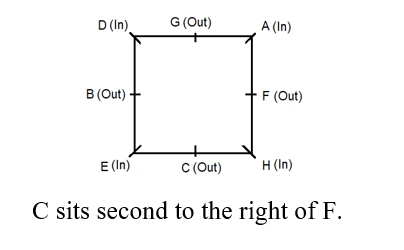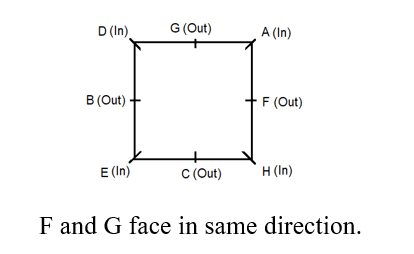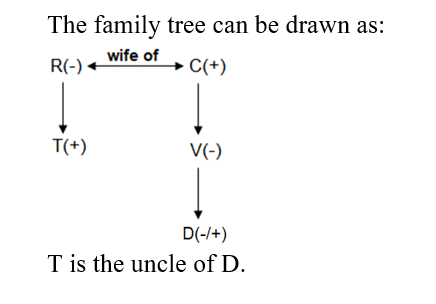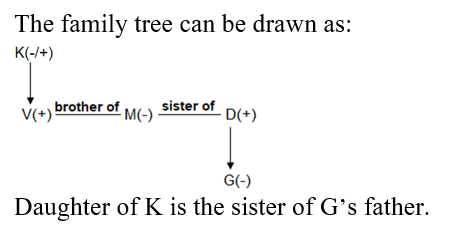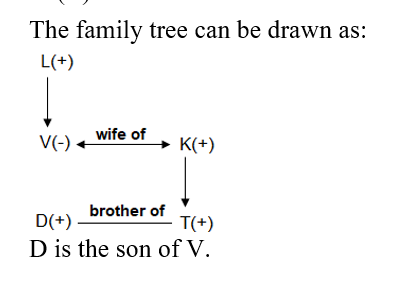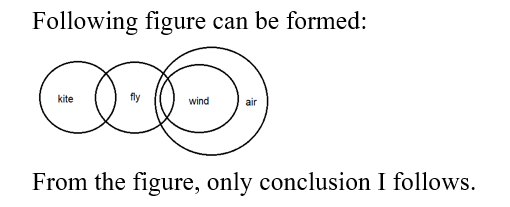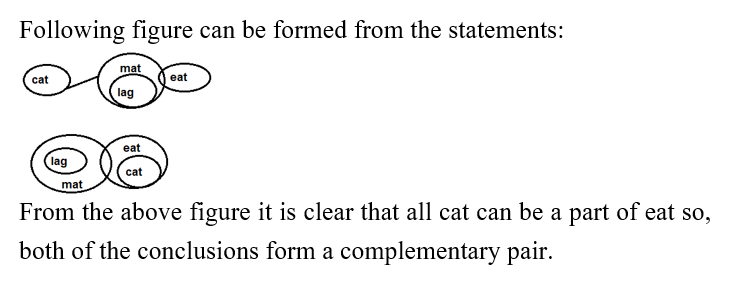Question 1:
Directions: Answer the questions based on the information given below.
निर्देश: दिए गए जानकारी के आधार पर सवालों के उत्तर दें।
Eight persons A, B, C, D, E, F, G and H are sitting around the square table. Four persons sit on the middle of each side while four sit on the corners. Persons at the corner face towards the center while person along the sides face away from the center. No two persons with names starting with consecutive alphabets sit adjacent or opposite to each other.
C sits adjacent to H. A and G are immediate right of each other. H faces towards the center. B sits second to the left of G. E and D face in same direction.
आठ व्यक्ति A, B, C, D, E, F, G और H एक वर्गाकार मेज़ पर बैठे हैं। चार व्यक्ति प्रत्येक भुजा के मध्य पर बैठे हैं जबकि शेष चार व्यक्ति कोने पर बैठे हैं।कोने पर बैठे व्यक्ति केंद्र का सामना करते हैं जबकि भुजा पर बैठे व्यक्ति केंद्र से बाहर का सामना करते हैं। वैसे कोई दो व्यक्ति एक दूसरे के विपरीत या बगल में नहीं बैठे है जिनके नाम लगातार अक्षरों से शुरू होते हैं।
C, H के बगल में बैठा है। A और G एक दूसरे के तत्काल दाएँ ओर बैठे हैं। H केंद्र का सामना करता है। B, G के बाएं से दूसरे स्थान पर बैठा है। E और D समान दिशा का सामना करते हैं।
Who among the following sits opposite to G?
निम्नलिखित में से कौन G के विपरीत बैठा है?
Question 2:
Directions: Answer the questions based on the information given below.
निर्देश: दिए गए जानकारी के आधार पर सवालों के उत्तर दें।
Eight persons A, B, C, D, E, F, G and H are sitting around the square table. Four persons sit on the middle of each side while four sit on the corners. Persons at the corner face towards the center while person along the sides face away from the center. No two persons with names starting with consecutive alphabets sit adjacent or opposite to each other.
C sits adjacent to H. A and G are immediate right of each other. H faces towards the center. B sits second to the left of G. E and D face in same direction.
आठ व्यक्ति A, B, C, D, E, F, G और H एक वर्गाकार मेज़ पर बैठे हैं। चार व्यक्ति प्रत्येक भुजा के मध्य पर बैठे हैं जबकि शेष चार व्यक्ति कोने पर बैठे हैं।कोने पर बैठे व्यक्ति केंद्र का सामना करते हैं जबकि भुजा पर बैठे व्यक्ति केंद्र से बाहर का सामना करते हैं। वैसे कोई दो व्यक्ति एक दूसरे के विपरीत या बगल में नहीं बैठे है जिनके नाम लगातार अक्षरों से शुरू होते हैं।
C, H के बगल में बैठा है। A और G एक दूसरे के तत्काल दाएँ ओर बैठे हैं। H केंद्र का सामना करता है। B, G के बाएं से दूसरे स्थान पर बैठा है। E और D समान दिशा का सामना करते हैं।
How many persons sit between H and B when counted from left of H?
H के बाएं ओर से गणना करने पर H और B के बीच कितने व्यक्ति बैठे हैं?
Question 3:
Directions: Answer the questions based on the information given below.
निर्देश: दिए गए जानकारी के आधार पर सवालों के उत्तर दें।
Eight persons A, B, C, D, E, F, G and H are sitting around the square table. Four persons sit on the middle of each side while four sit on the corners. Persons at the corner face towards the center while person along the sides face away from the center. No two persons with names starting with consecutive alphabets sit adjacent or opposite to each other.
C sits adjacent to H. A and G are immediate right of each other. H faces towards the center. B sits second to the left of G. E and D face in same direction.
आठ व्यक्ति A, B, C, D, E, F, G और H एक वर्गाकार मेज़ पर बैठे हैं। चार व्यक्ति प्रत्येक भुजा के मध्य पर बैठे हैं जबकि शेष चार व्यक्ति कोने पर बैठे हैं।कोने पर बैठे व्यक्ति केंद्र का सामना करते हैं जबकि भुजा पर बैठे व्यक्ति केंद्र से बाहर का सामना करते हैं। वैसे कोई दो व्यक्ति एक दूसरे के विपरीत या बगल में नहीं बैठे है जिनके नाम लगातार अक्षरों से शुरू होते हैं।
C, H के बगल में बैठा है। A और G एक दूसरे के तत्काल दाएँ ओर बैठे हैं। H केंद्र का सामना करता है। B, G के बाएं से दूसरे स्थान पर बैठा है। E और D समान दिशा का सामना करते हैं।
Find the odd one out.
विषम का चुनाव करें।
Question 4:
Directions: Answer the questions based on the information given below.
निर्देश: दिए गए जानकारी के आधार पर सवालों के उत्तर दें।
Eight persons A, B, C, D, E, F, G and H are sitting around the square table. Four persons sit on the middle of each side while four sit on the corners. Persons at the corner face towards the center while person along the sides face away from the center. No two persons with names starting with consecutive alphabets sit adjacent or opposite to each other.
C sits adjacent to H. A and G are immediate right of each other. H faces towards the center. B sits second to the left of G. E and D face in same direction.
आठ व्यक्ति A, B, C, D, E, F, G और H एक वर्गाकार मेज़ पर बैठे हैं। चार व्यक्ति प्रत्येक भुजा के मध्य पर बैठे हैं जबकि शेष चार व्यक्ति कोने पर बैठे हैं।कोने पर बैठे व्यक्ति केंद्र का सामना करते हैं जबकि भुजा पर बैठे व्यक्ति केंद्र से बाहर का सामना करते हैं। वैसे कोई दो व्यक्ति एक दूसरे के विपरीत या बगल में नहीं बैठे है जिनके नाम लगातार अक्षरों से शुरू होते हैं।
C, H के बगल में बैठा है। A और G एक दूसरे के तत्काल दाएँ ओर बैठे हैं। H केंद्र का सामना करता है। B, G के बाएं से दूसरे स्थान पर बैठा है। E और D समान दिशा का सामना करते हैं।
Who sits second to the right of F?
F के दाएँ से दूसरे स्थान पर कौन बैठा है?
Question 5:
Directions: Answer the questions based on the information given below.
निर्देश: दिए गए जानकारी के आधार पर सवालों के उत्तर दें।
Eight persons A, B, C, D, E, F, G and H are sitting around the square table. Four persons sit on the middle of each side while four sit on the corners. Persons at the corner face towards the center while person along the sides face away from the center. No two persons with names starting with consecutive alphabets sit adjacent or opposite to each other.
C sits adjacent to H. A and G are immediate right of each other. H faces towards the center. B sits second to the left of G. E and D face in same direction.
आठ व्यक्ति A, B, C, D, E, F, G और H एक वर्गाकार मेज़ पर बैठे हैं। चार व्यक्ति प्रत्येक भुजा के मध्य पर बैठे हैं जबकि शेष चार व्यक्ति कोने पर बैठे हैं।कोने पर बैठे व्यक्ति केंद्र का सामना करते हैं जबकि भुजा पर बैठे व्यक्ति केंद्र से बाहर का सामना करते हैं। वैसे कोई दो व्यक्ति एक दूसरे के विपरीत या बगल में नहीं बैठे है जिनके नाम लगातार अक्षरों से शुरू होते हैं।
C, H के बगल में बैठा है। A और G एक दूसरे के तत्काल दाएँ ओर बैठे हैं। H केंद्र का सामना करता है। B, G के बाएं से दूसरे स्थान पर बैठा है। E और D समान दिशा का सामना करते हैं।
Who among the following face in same direction as F?
निम्नलिखित में से कौन उस दिशा का सामना करता है जिस दिशा का सामना F करता है?
Question 6:
Directions: Study the information below and answer the following questions.
निर्देश: दिए गए जानकारी के आधार पर सवालों के उत्तर दें।
A @ B का अर्थ है A B की माता है।
A # B का अर्थ है A B का पुत्र है।
A $ B का अर्थ है A B का पिता है।
A % B का अर्थ है A B की बहन है।
A ^ B का अर्थ है A B की पुत्री है।
A & B का अर्थ है A B की पत्नी है।
A * B का अर्थ है A B का भाई है।
A @ B means A is the mother of B.
A # B means A is the son of B.
A $ B means A is the father of B.
A % B means A is the sister of B.
A ^ B means A is the daughter of B.
A & B means A is the wife of B.
A * B means A is the brother of B.
If expression ‘T # R & C $ V @ D’ is true then how is T related to D?
यदि समीकरण ‘T # R & C $ V @ D’ सत्य है तो T D से कैसे सम्बंधित है?
Question 7:
Directions: Study the information below and answer the following questions.
निर्देश: दिए गए जानकारी के आधार पर सवालों के उत्तर दें।
A @ B का अर्थ है A B की माता है।
A # B का अर्थ है A B का पुत्र है।
A $ B का अर्थ है A B का पिता है।
A % B का अर्थ है A B की बहन है।
A ^ B का अर्थ है A B की पुत्री है।
A & B का अर्थ है A B की पत्नी है।
A * B का अर्थ है A B का भाई है।
A @ B means A is the mother of B.
A # B means A is the son of B.
A $ B means A is the father of B.
A % B means A is the sister of B.
A ^ B means A is the daughter of B.
A & B means A is the wife of B.
A * B means A is the brother of B.
If expression ‘G ^ D * M % V # K’ is true then how is daughter of K related to G’s father?
यदि समीकरण ‘G ^ D * M % V # K’ सत्य है तो K की पुत्री G के पिता से कैसे सम्बंधित है?
Question 8:
Directions: Study the information below and answer the following questions.
निर्देश: दिए गए जानकारी के आधार पर सवालों के उत्तर दें।
A @ B का अर्थ है A B की माता है।
A # B का अर्थ है A B का पुत्र है।
A $ B का अर्थ है A B का पिता है।
A % B का अर्थ है A B की बहन है।
A ^ B का अर्थ है A B की पुत्री है।
A & B का अर्थ है A B की पत्नी है।
A * B का अर्थ है A B का भाई है।
A @ B means A is the mother of B.
A # B means A is the son of B.
A $ B means A is the father of B.
A % B means A is the sister of B.
A ^ B means A is the daughter of B.
A & B means A is the wife of B.
A * B means A is the brother of B
If expression ‘L $ V & K $ T * D’ is true then how is D related to V, if D is a male member?
यदि समीकरण ‘L $ V & K $ T * D’ सत्य है तो D V से कैसे सम्बंधित है, यदि D एक पुरुष सदस्य है
Question 9:
In the question below there are three statements followed by three conclusions I, II and III. You have to take the three given statements to be true even if they seem to be at variance from commonly known facts and then decide which of the given conclusions logically follows from the three statements disregarding commonly known facts.
निम्नलिखित प्रश्न में तीन कथन के बाद तीन निष्कर्ष I, II और III दिए गए हैं। आपको दिए गए कथन को सत्य मानना है भले ही वह ज्ञात तथ्यों से भिन्न भी हो और फिर यह तय करना है कि दिए गए निष्कर्षों में से कौन सा निष्कर्ष इन कथनों का तर्कसंगत अनुसरण करता है।
Statements: Some kite are fly.
कथन:कुछ काइट फ्लाई है।
Some fly are wind.
कुछ फ्लाई विंड है।
All wind are air.
सभी विंड एयर है।
Conclusions: I. Some fly are air.
निष्कर्ष: I. कुछ फ्लाई एयर है।
II. Some kite are wind.
II. कुछ काइट विंड है।
III. All kite are air.
III. सभी काइट एयर है।
Question 10:
In the question below there are three statements followed by two conclusions I and II. You have to take the three given statements to be true even if they seem to be at variance from commonly known facts and then decide which of the given conclusions logically follows from the three statements disregarding commonly known facts.
निम्नलिखित प्रश्न में तीन कथन के बाद दो निष्कर्ष I और II दिए गए हैं।आपको दिए गए कथन को सत्य मानना है भले ही वह ज्ञात तथ्यों से भिन्न भी हो और फिर यह तय करना है कि दिए गए निष्कर्षों में से कौन सा निष्कर्ष इन कथनों का तर्कसंगत अनुसरण करता है।
Statements: No cat is mat.
कथन: कोई कैट मैट नहीं है।
Only mat is lag.
केवल मैट लेग है।
Some mat is eat.
कुछ मैट ईट है।
Conclusions: I. Some cat is not eat.
निष्कर्ष: I. कुछ कैट ईट नहीं है।
II. All cat is eat.
II. सभी कैट ईट है।

